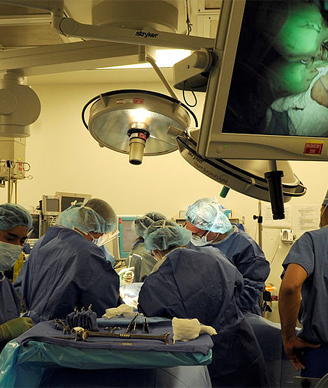Sharp Rise in Mastectomy in Early-Stage Breast Cancer
A retrospective cohort study of women treated for early-stage breast cancer has confirmed rising trends in the proportion of patients who undergo mastectomy.
A retrospective study has confirmed rising trends in mastectomy in early-stage breast cancer.

A retrospective cohort study of more than 1.2 million women treated for early-stage breast cancer in the United States has confirmed rising trends in the proportion of patients who undergo mastectomy, bilateral mastectomy, and breast reconstruction rather than breast conservation surgery for which they are eligible. Findings were reported in JAMA Surgery by Kristy L. Kummerow, MD, of the division of surgical oncology and endocrine surgery, and colleagues at the Vanderbilt University Medical Center and Tennessee Valley Healthcare System, Nashville, Tennessee.
Breast conservation surgery was endorsed by the National Institutes of Health Consensus Conference in 1990 after studies demonstrated equivalent outcomes with mastectomy in early-stage breast cancer, “and has become a standard of excellence in breast cancer care,” noted the authors. Accredited breast centers in the United States are thus measured on performance of breast conservation surgery in more than 50% of women who are eligible.
All participants in the study were treated at centers accredited by the American Cancer Society and the American College of Surgeons Commission on Cancer from January 1, 1998, to December 31, 2011, using the National Cancer Data Base. The study was designed to determine the proportion of women with early-stage breast cancer who underwent mastectomy. Secondary outcome measures included temporal trends in breast reconstruction and bilateral mastectomy for unilateral disease.
A total of 64.5% of patients underwent breast conservation surgery while 35.5% underwent mastectomy. Those who underwent breast conservation surgery differed from those who underwent mastectomy by demographic and tumor characteristics. The mastectomy group included fewer racial and ethnic minorities. Mastectomy was more likely to be performed in women with more comorbid conditions; those with managed care, Medicare, or no insurance; women treated in the South or in areas with a lower educational level; and in women whose tumors were invasive (versus in situ), larger, less differentiated, or associated with clinically positive nodes.
Among patients treated with mastectomy, 45% underwent total mastectomy, 34.7% had modified radical mastectomy, 19.5% had bilateral mastectomy, and 0.8% had radical mastectomy, the investigators reported. “The proportion of breast conservation surgery–eligible women who underwent mastectomy increased from 34.3% in 1998 to 37.8% in 2011 (P < .001 for trend). In the general multivariable model for the most recent 8 years, the odds of mastectomy increased 34% by 2011 relative to 2003 (odds ratio = 1.34; 95% CI, 1.31-1.38), with the most notable rise in mastectomy rates occurring after 2006.”
Temporal trends were similar for the secondary outcomes, with notable increases in the proportion of women who underwent breast reconstruction and bilateral mastectomy starting in the mid-2000s, with a continued increasing trend over time. Breast reconstruction in women undergoing mastectomy rose dramatically from 11.6% in 1998 to 36.4% in 2011, noted the authors. Bilateral mastectomy for unilateral disease increased from 1.9% of breast conservation surgery-eligible women in 1998 to 11.2% in 2011. And bilateral mastectomy increased from 5.4% in 1998 to 29.7% in 2011 among women undergoing any type of mastectomy for unilateral disease. Reconstruction was performed in 57.2% of women who underwent bilateral mastectomy in 2011 compared with 36.9% in 1998.
Although the increase in bilateral mastectomy in unilateral disease is not well understood, the authors noted that qualitative studies suggest that physician recommendation, patient concern about recurrence, increased use of breast magnetic resonance imaging (MRI), and desire for symmetry are the main reasons women opt to undergo bilateral mastectomy. Multiple factors are involved when physicians and patients decide how to surgically manage an individual breast cancer case, the authors continued, citing a study on decision-making in patients with early-stage breast cancer that demonstrated greater discordance between patient goals and ultimate surgical treatment in women who underwent mastectomy than in those who underwent breast conservation surgery. “Furthermore, less than 50% of women reported being asked by their physicians whether they preferred breast conservation surgery or mastectomy, and more than 80% of women reported that their physicians made a specific recommendation for either breast conservation surgery or mastectomy.”
Findings of the present study have “implications for physician and patient decision-making as well as quality measurement,” the investigators concluded. “Further research is needed to understand patient, provider, policy, and social factors associated with these trends.”
Commenting on the findings, Mehra Golshan, MD, director of breast surgical services at Dana-Farber/Brigham and Women’s Cancer Center, Boston, said, “This study adds to the literature that is already out there on the subject. We have seen an increase in our prophylactic mastectomy rates and also for women who are eligible for breast conservation, to the mastectomies, including bilateral mastectomy, for almost a decade now. This is a trend that is in contrast to almost every other area in surgery where we’ve gone toward the less invasive, whether it’s robotic, laparoscopic, endoscopic-it’s always less rather than more invasive. And we’ve known for many years that mastectomy and breast conservation give the same outcomes for most women with early-stage breast cancer in terms of survival. The trend is disturbing but it has been known for awhile and a lot of people are looking at factors.”
2 Commerce Drive
Cranbury, NJ 08512
All rights reserved.